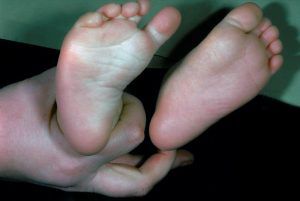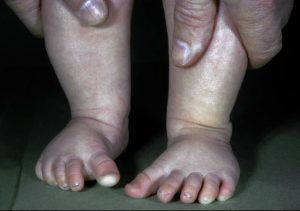Metatarsus Adductus

What is Metatarsus Adductus?
Metatarsus Adductus, also called Metatarsus Varus, is a condition that affects the front half of the foot (forefoot) which bends and turns inward.
In this pathology midfoot and rearfoot axes are normal.
The foot may be flexible if it is possible to straighten it by hand, or, less often, non-flexible.
What causes metatarsus adductus?
The cause of this congenital condition is not known. It is believed to depend on the child position in the mother’s womb.
The cause of this congenital condition is not known. It is believed to depends on the child position in the mother’s womb.
It occurs in approx. 1 of 1,000/2,000 live births and it is more common in first-born children.
Babies with metatarsus adductus may be at increased risk for developmental hip dysplasia
How is metatarsus adductus diagnosed?
 The doctor must make the diagnosis with a physical examination. He will need to know the complete birth history of the baby and if other family members had metatarsus adductus.
The doctor must make the diagnosis with a physical examination. He will need to know the complete birth history of the baby and if other family members had metatarsus adductus.
In the case of non-flexible metatarsus adductus X-rays of the feet may be necessary for a better evaluation.
Visually the foot of a child with metatarsus adductus has a high arch and the big toe has widely separated from the second toe and deviates inward.
Metatarsus adductus treatments
Treatments depend on several factors such as child’s age, state of health and on how severe the condition is.
They may include:
- Observation
If the child has a flexible forefoot, in the majority of cases (more than 90%), metatarsus adductus may improve spontaneously without any treatment. - Stretching or passive manipulation exercises
If therapy is started at an early stage it leads to a resolution within 40-60 days in most cases. Sometimes also change in sleeping positions may be recommended, as well.(i.e. side-lying positioning) - Casts or Braces
Sometimes, when the child’s foot don’t respond well to a stretching program braces or casts may be used as well. Casts help stretch the soft tissue of the forefoot and they may be changed every 1 or 2 weeks. In addition to casting, straight last shoes may be used to hold the forefoot in place. - Surgery is only needed in cases of stiffness and when the degree of deviation is severe. It consists in the surgical section of the abductor hallucis muscle in association with the capsulotomy of the first metatarsal–cuneiform joint.
About us
Prof. Portinaro has been treating metatarsus adductus for more than 30 years.
He performed around 100 surgeries with a 95% of success.
